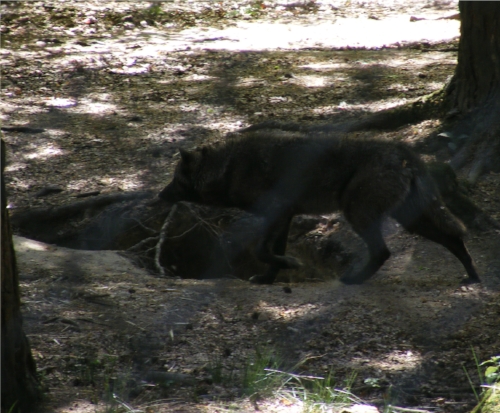The Wolves of the 'Moon Goddess'
Today’s updated post is about wolves, which play an important part in the novel. Again, the ‘extra’ parts are marked with asterisks.
* According to Barry Lopez, in his highly informative and very readable book, ‘Of Wolves and Men’:
“The wolf exerts a powerful influence on the human imagination. It takes your stare and turns it back on you… The Bella Coola Indians believed that someone once tried to change all the animals into men but succeeded in making human only the eyes of the wolf”.*
So, why did I choose wolves to feature in the story? Apart from being one of my most favourite animals, and the fact that they’re associated with goddesses of the moon and the hunt, it’s because they are highly intelligent and social. Another reason – what might be termed a perverse one – is that wolves were persecuted. I do not wish to single out the Roman Church, but, historically, they took advantage of the medieval peasant’s superstitious fear of the wolf.
In the Middle Ages, wolves were a real threat to the peasant’s way of life because they attacked domestic animals. Occasionally, a starving wolf would kill a traveller. During the Black Death, with too many dead bodies and not enough space to bury them, starving wolves did eat the dead. And, in times of war, packs of wolves were known to follow armies, to feast, mainly, on the dead horses. However, I don’t believe wolves eating people was as regular an occurrence as was claimed. The ‘party line’ about wolf attacks was more likely to have been used as a way to ‘encourage’ peasants to remain with and continue serving their feudal lords.
Especially during the time of the Inquisition, wolves and other ‘undesirables’ like gypsies were caught in the net as the Church fought to suppress political unrest and tighten its influence and control over the populace. Tales were told to frighten the people into avoiding the woods because that was where man-eating wolves and terrifying witches lurked.
(New Forest National Park 2011)
A nocturnal creature, the wolf was more likely to be seen at dawn and dusk. Because the moon is mainly associated with the goddess, so the wolf was linked with her and the moon, and with the night. This added to the wolf’s fearsome reputation because the night was connected with things that cannot be seen, that exist in the shadows, things that can only be considered sinister.
Yet, the dichotomous nature of the wolf prevailed. In areas where it was considered dangerous, the benevolent side of the wolf continued to exist. For example, in France, the wolf is seen as a spirit of the crops…
‘When the wind blows in waves across the fields, the peasants say “the wolf is going through… If a wolf is seen out in the fields they look to see if it carries its tail high or low. If the tail hangs straight down it is the crop spirit himself, and they salute him…’ (‘Of Wolves and Men’, Barry Lopez)
By making the wolf an integral part of the story, I wanted to show the more benevolent, caring side of a creature better known for its fearsome reputation.
* As we know, wolves live in packs made up of an extended family; their social structures are more sophisticated than people realise, I think. The typical pack size is about 5 to 8 individuals but can be as small as 2 or as large as 15 or 20.
It’s common for only one female in a pack to become pregnant, typically in April and May. The gestation period is about 63 days. The pups are usually born in a den specially excavated for the purpose.
The normal litter size is about 4 to 6 pups, though the number born depends on how much game is available and the number of wolves in the area. The pups are born deaf and blind. While they are able to hear after a few days, their eyes don’t open for another 11 to 15 days. They are usually weaned at about 5 weeks. I find this really cute – when they howl for the first time, around 4 weeks, the sound is so sudden, it startles them.
Sadly, with high mortality rates, not many survive. But those that do have the attention and affection of the entire pack, not just their parents. The pups nuzzle the adults and play with them.
The adults show little or no aggression around their food… “Older wolves make no effort to snatch food from the pups or, after, to keep them from feeding on a kill. Observers in the wild, in fact, have frequently commented on how benignly a pack of wolves behaves around a carcass.” (‘Of Wolves and Men’, Barry Lopez)
Their social bond is so obvious, it was even commented on favourably in the 16th century, at a time when wolves had a particularly bad reputation.
The man instrumental in protecting wolves from eradication, and who spent many years in the wild studying them, Adolph Murie, wrote of the wolves’ friendliness toward each other and their love of play.*
By including the wolf in my story, I’m not attempting to paint it as a saint. Like any other animal, including humans, it is neither completely good nor totally bad; it is just another living being in the world that we inhabit. To quote Henry Beston:
“…[animals] are other nations, caught with ourselves in the net of life and time, fellow prisoners of the splendour and travail of the earth.”
(New Forest National Park 2010)


